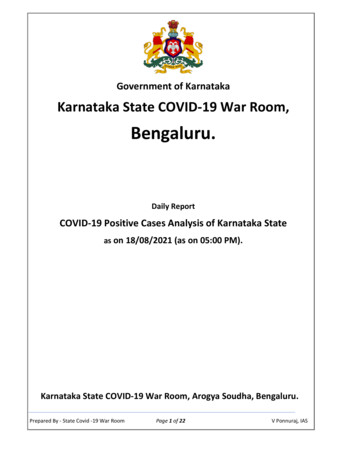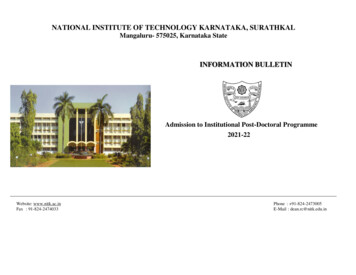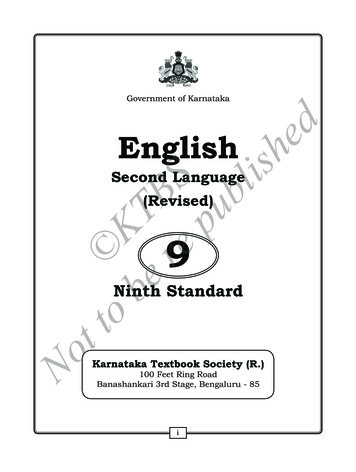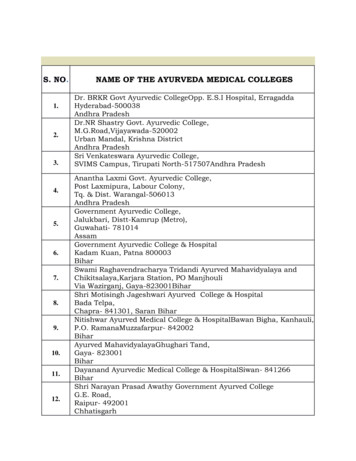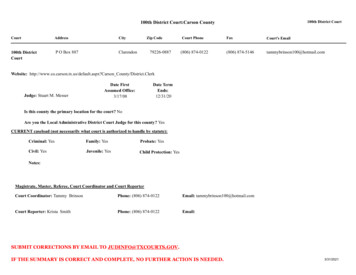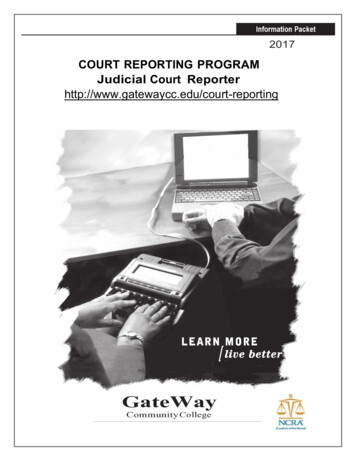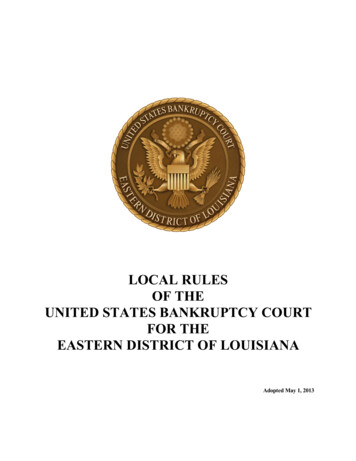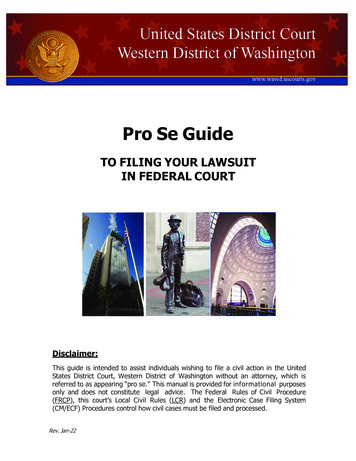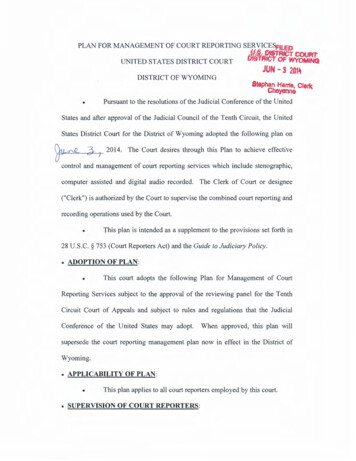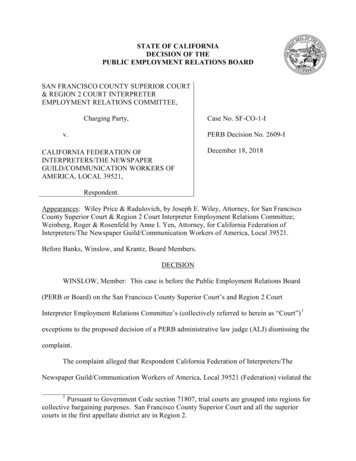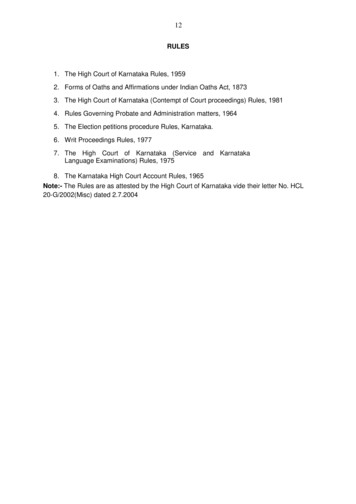
Transcription
12RULES1. The High Court of Karnataka Rules, 19592. Forms of Oaths and Affirmations under Indian Oaths Act, 18733. The High Court of Karnataka (Contempt of Court proceedings) Rules, 19814. Rules Governing Probate and Administration matters, 19645. The Election petitions procedure Rules, Karnataka.6. Writ Proceedings Rules, 19777. The High Court of Karnataka (Service and KarnatakaLanguage Examinations) Rules, 19758. The Karnataka High Court Account Rules, 1965Note:- The Rules are as attested by the High Court of Karnataka vide their letter No. HCL20-G/2002(Misc) dated 2.7.2004
13THE HIGH COURT OF KARNATAKA RULES, 1959CONTENTSChapterI. PreliminaryII. Definitions and interpretationsIII. Constitution of BenchesIV. Officers of the CourtV. Practitioners of the CourtVI. AppealsVI-A. Original Side AppealsVII. PetitionsVIII. Special Rules regarding Writ PetitionsIX. ReferencesX. Interlocutory mattersXI. AffidavitsXII. Presentation and examination of PapersXIII. Issue and service of noticeXIV. Preparation of records of the casesXV. Postings and adjournments of casesXVI. Judgments, Decrees and OrdersXVI-A. CostsXVII. CopiesXVIII. Searches and inspection of recordsXIX. Appeals to the Supreme Court1[XX. Destruction of Records]Forms11. Chapter XX inserted by Notification No. HCE 395 of 1991 dt 27.10.1992 w.e.f. 5.11.1992
14THE HIGH COURT OF KARNATAKA RULES, 1959High Court of Karnataka, BangaloreNOTIFICATIONNo.R.O.C.2296-59, dated 6th October 1959.In exercise of the powers conferred by Article 225 of the Constitution of India andsection 54 of the States Reorganisation Act, 1956 (Central Act 37 of 1956) read withsections 122 and 129 of the Code of Civil Procedure, 1908, and section 19 of the MysoreHigh Court Act (I of 1884) and all other powers thereunto enabling, the High Court ofKarnataka, with the previous approval of the Government of Karnataka, promulgates andissue the following Rules with respect to practice and procedure to be followed at the HighCourt, the same having been previously published for objections and suggestions in theKarnataka Gazette, dated 27th June 1957.CHAPTER IPreliminary1. These Rules may be cited as the High Court of Karnataka Rules, 1959.2. These Rules will come into force on the date of their publication in the KarnatakaGazette.3. They shall apply to all proceedings and matters in the High Court commenced onand after the said date and shall also apply, as far as may be practicable, to all proceedingstaken on and after the said date in all causes and matters then pending in the High Court. Ifany doubt or difficulty arises in the application of any of these Rules to pending causes ormatters, the relative papers shall be placed before the Admission Judge who may pass suchorder as he considers just and proper in the circumstances of the case, and a compliancewith such order shall be sufficient compliance with the provisions of these Rules.4. On the coming into force of these Rules all existing Rules, Orders, Circulars,Practice, Convention or the like governing any matter dealt with or covered by these Rulesshall stand repealed:Provided that this repeal shall not affect or invalidate anything done, any action ordecision taken, any disposal made, any decree, order or proceeding made or issued underthe existing Rules before the commencement of the Rules.5. The Forms prescribed by or under these Rules shall be used for the purposes or theproceedings for which they are prescribed with such modifications as the circumstances ofthe case may require.6. Where any forms, fees, charges or other matters required by these Rules are notprescribed by these Rules themselves, they may be determined or settled by or inaccordance with the directions of the Chief Justice.CHAPTER IIDefinitions and Interpretations1. In these Rules, unless the context indicates the contrary,(a) “High Court”, “This Court” or “The Court” means the High Court of Karnatakaestablished under the Constitution of India and in accordance with the provisions of sub-
15section (2) of section 49 of the States Reorganisation Act, 1956 (Central Act 37 of 1955) forthe State of Karnataka constituted under the said Act:(b)“Chief Justice” means the Chief Justice of the High Court;(c)“Judge” means a Judge of the High Court;(d)“Vacation Judge” means a Judge on duty during a vacation;(e) “Admission Judge” or “Admission Court” means the Judge for the time beingdealing with admission of cases and with interlocutory applications;(f) “Bench” means a Bench of Judges and shall included single Judge in relation tomatters which can be disposed of by a single Judge;(g)“Full Bench” means a Bench consisting of three or more Judges;(h) “Appropriate Bench” means in relation to any matter the Bench which iscompetent under these rules to dispose of the said matter finally;“Registrar” means the Registrar of the High Court and includes the 1[AdditionalRegistrar, Joint Registrar]1 Deputy Registrar or an Assistant Registrar of the High Court, inrelation to the powers, duties or functions of the Registrar exercised or performed by the1[Additional Registrar, Joint Registrar]1, Deputy Registrar or the Assistant Registrar as thecase may be;(i)1. Substituted by Notification 2893 of 1969 dated 24/27.1.90 w.e.f. 5.2.1970(j)“Constitution” means the Constitution of India;(k) “Code” (except when it occurs in “Code of Civil Procedure” or “Code of CriminalProcedure”) means the Code of Civil Procedure in relation to Civil Matters and the Code ofCriminal Procedure in relation to Criminal Matters;(l)“Supreme Court” means the Supreme Court of India;(m) “Supreme Court Rules” means the Rules of the Supreme Court for the time beingin force;(n) “Subordinate Court” means any Court, Tribunal or Authority whose decrees,orders, sentences or proceedings are subject to appeal, reference, revision to or by the HighCourt under any law for the time being in force, or are subject to the jurisdiction of the HighCourt under Article 226 of the Constitution or to its superintendence under Article 227 of theConstitution;(o) “Certified Copy” shall have the same meaning as is assigned to it in section 76 ofthe Indian Evidence Act;(p) “To admit a case” means to decide to issue notice to respondent or direct issue ofnotice to respondent after preliminary perusal of papers or preliminary hearing under theprovisions of Order 41, Rule 11 of the Code of Civil Procedure or section 421 of the Code ofCriminal Procedure or any other like provision of any other law for the time being in force;The words “Admission”, “For Admission” or similar expressions shall be construedaccordingly.Where upon such preliminary perusal or hearing the Court decides not to issuenotice, the case is said to be dismissed summarily;
16(q) “To Admit a Case to Register” or “To Register a Case” means entering thesame in the appropriate register and giving it a number in accordance with the practice ofthe Court after the Registrar is satisfied that the papers of the particular case have beenpresented to the High Court within the time, if any, limited therefore by any law for the timebeing in force, that proper court fee, if any, payable in respect of those papers has beenpaid, that all enclosures required by or under these Rules have been furnished and that thepapers in all respects comply with the provisions of law and of these Rules applicable to thesame relating to the presentation of such papers;(r) “A pre-decree case” means an appeal, reference or petition presented to theCourt against or in respect of any order or other determination of a Subordinate Court in amatter pending before such Court and not finally disposed of by such Court;(s) “Prescribed” means prescribed by or under these Rules.CHAPTER - IIIConstitution of Benches1[1 XXX2 XXX3 XXX4 XXX]11. Rules 1, 2, 3, 4 omitted by Notification No. ROC 2 of 1962 dated 27.1.1962 w.e.f. 1.2.19625. Every petition or application for review, reconsideration or correction of ajudgment, decree, order or sentence shall be posted before the original Bench whichpronounced, made or passed such judgment, decree, order or sentence or if the Judge orany of the Judges who constituted the said Bench is not available by reason of death,retirement or absence, before any other Bench constituted in the same manner as theoriginal Bench.6. Benches shall be constituted and judicial work of the Court allotted or distributed tothem by or in accordance with the directions of the Chief Justice.7. When a single Judge refers a case to a Bench or when a Bench of two Judgesrefers any question to a Full Bench, then the papers of the particular case shall be placedbefore the Chief Justice for a reference to a Bench or for the constitution of a Full Bench.1[ 8. X X X9. X X X ]11. Rules 8 and 9 omitted by Notification No. ROC 2 of 1962 dated 27.1.1962 w.e.f. 1.2.1962CHAPTER - IVOfficers of the Court1. In addition to the powers and authorities conferred by these and other Rules, theRegistrar shall have and exercise the following powers subject to any general or specialorder made by the Chief Justice:-
17(1) To receive all appeals, petitions, applications or other proceedings presented tothe Court.(2) To examine all such appeals, petitions and other proceedings and satisfy himselfthat the same have been presented within the time prescribed therefore, are in proposedform, contain the particulars required by law and these Rules, are duly stamped with propercourt fee, are accompanied by necessary enclosures and in all respects comply with all theprovisions of law and these Rules applicable to their presentation and on being so satisfiedadmit them to register and number the same.1[2-A) To allow from time to time any period or periods not exceeding ten days in allfor filing annexures, postal covers and acknowledgments, furnishing information, or for doingany similar act necessary to make an appeal or a petition or application or other proceedingcomplete.]11. Sub Rule 2A added by Notification No. ROC 2892 of 1969 dated 21/24.2.1970 w.e.f. 5.3.1970(3) To require any such appeal, petition, application or other proceeding to beamended and return the same to the party presenting the same or to his Advocate, to bere-presented after removal of defects pointed out or in compliance with the requisition made.(4) To decide all questions necessary for fully discharging his duties under theprovisions of sub-rules (1), (2) and (3).(5) To admit all civil appeals and to issue notices to respondents therein subject to thefollowing conditions: (a) In appeals against original decrees and orders of subordinate Civil Courts underthe Code, he shall issue notice to respondents forthwith the appeals have been presentedwithin the time limit prescribed therefor by law and otherwise comply with all the provisionsof law and these Rules relating to the same.(b) In appeals against original orders of the subordinate Courts under enactmentsother than the Code of Civil Procedure where an appeal lies as of right both on facts and onlaw, he shall determine whether notice shall issue or the appeal be posted before theappropriate Bench for admission and if he decides on the latter alternative post the appealaccordingly.(c) In appeals against appellate decrees and orders of subordinate Civil Courts, andagainst original orders under any enactment which gives a right of appeal against suchorders only upon specified conditions or restrictions, he shall post the same before a properBench for admission.(6) To fix the date of return of any notice subject to directions of Court, if any.(7) To dispense with service of notice to respondents, other than minors, under theprovisions of Order XLI Rules 14 of the Code of Civil Procedure.(8) To determine the sufficiency of service or otherwise of any notice, and to orderissue of fresh notice or substituted service.(9) To extend the time for a period or periods not exceeding six weeks in theaggregate for payment of process fee or printing or typing changes or other fees andcharges payable under these Rules, or for doing any act necessary to make appeals,petitions, applications or other proceedings ready for hearing.
18(10) To give time for payment of deficient court fee on any appeal.(11) To fix the date of hearing of any matter subject to directions of Court, if any.(12) To postpone or adjourn cases ready for hearing on the written request of parties or(13) their Advocates, with notice to other Advocates appearing in the case.(14)To require any person or party to file any evidence to be given on affidavit in(15)respect of any matter in respect of which he has power to exercise any discretionor make any order.2. The Registrar may hear and dispose of the following applications:1[(1) X X X(2) X X X(3) X X X(4) X X X]11. Clauses 1 to 4 of Rule 2 Omitted by Notification No. ROC 2 of 1962 dated 27.1.1962 w.e.f. 1.2.19621[(1) Applications by Court Guardians for funds or for supply of papers or the like.(2) Applications to dispense with production of enclosures as required by these Rulesor for condonation of formal defects in papers.(3) Applications for return of documents.(4) Applications to call for records not produced by a party or to send for, either from therecords of the High Court or from any other Court, records of or documents filed in anysuit or proceeding other than the one in which the application is made.(5 )Application for issue of certified copies.(6) Applications for inspection or search of records of any matter pending in theHigh Court.(7 )Applications for change or revocation of vakalat or for withdrawal of appearance.(8) Applications under Rule 17(2) of Chapter VIII of these Rules.(9) Uncontested applications under Rule 12 or Rule 19(2) of Chapter XIV of theseRules.(10) Applications for leave to take documents from the custody of the Court in pendingmatters.(11) Applications for issue of a certificate regarding excess Court-fees paid under amistake.(12) Applications for condoning delay in paying deficit Court-fees.(13) Applications for condonation of delay in filing statement of objections/counter/replynot exceeding 30 days.(14) Applications for withdrawal of the case before notice is ordered to the oppositeparty, provided such withdrawal is without liberty to file a fresh case on the same case ofaction.(15) Applications for substitution, except where the substitution would involve settingaside an abatement or where the period of limitation, if any has expired.
(16) Applications for change or discharge of advocate on record.(17 )Applications for payment into Court.(18) Applications for extending returnable dates of warrants.(19) Applications to appoint or discharge a next friend or guardian of a minor or a personof unsound mind and direct amendment of the record thereon.(20) Applications for refund of security deposit or part thereof or for payment out ofsecurity deposit.(21) Applications for consolidation of cases for purposes of hearing and preparation ofrecord.(22) Applications for condonation of delay in re-filing provided the delay does not exceed90 days from the date of notifying defects.(23) Issue of fresh summons and notices.(24 )Applications for amendment of pleadings with the consent of all the appearingparties, or where the other side has not appeared.(25)All uncontested interlocutory Applications of formal nature.(26) Imposting costs on the party in default of compliance of the orders passed by theRegistrar.1. Sub Rule (5 to 13) in Rule-2 renumbered as sub-rules (1) to (9) & sub rules (10) to (26) added by NotificationNo.HCLC 65/2006 dated 25.05.2007 w.e.f.07/06/20073. The Registrar may with the previous approval of the Chief Justice, delegate any ofthe powers conferred on him by these Rules or other Rules to the 1[Additional Registrar,Joint Registrar] 1, Deputy Registrar or the Assistant Registrar and may cause his functionsunder sub-rules (1), (2) and (3) of Rule 1 of this Chapter or any of the ministerial functions tobe performed by any other officer or clerk of the Court subject to the supervision of eitherhimself or the Deputy Registrar or the Assistant Registrar.1. Substituted by Notification No. ROC 2893 of 1969 dated 24/27.1.1970 w.e.f. 5.2.19704. The Registrar while exercising his powers under this Chapter shall be deemed tobe performing quasi judicial functions within the meaning of section 128(2)(i) of the Code ofCivil Procedure and shall have the power of correction under section 152 of the Code inrespect of all orders passed by him in exercise of his powers.5. Any party dissatisfied by any order or proposed order or any direction of theRegistrar made or given in the exercise of powers under these Rules may require that the
19matter in respect of which the order has been made or is proposed to be made or thedirection given be placed before the Admission Judge for further consideration and ordersand thereupon the Registrar shall do so and act according to the orders of the Judge.CHAPTER VPractitioners of the Court1. Subject as hereinafter provided no Advocate or Practitioner shall be entitled toappear and act in any civil matter before the High Court unless he files into Court avakalatnama in prescribed from duly executed by or on behalf of the party for whom heappears.2. Any Advocate appearing on behalf of the Government or on behalf of any publicservant sued in his official capacity shall not be required to file a vakalatnama but he shallfile into Court a memorandum of appearance signed by him giving the number and causetitle of the matter, name of the party for whom he appears and the name of the person bywhom he is authorized to appear.1[2-A. (i) Wherein a criminal case before the High Court the accused is not representedby an Advocate and if the Court is satisfied that the accused has no sufficient means toengage an Advocate or where the accused remains absent and the interest of justice sorequires, the Court may appoint any Advocate from the panel prepared under Clause (iv)below to represent the accused in such case at the expense of the State.(ii) The fact and the date of appointment of the amicus curiae under clause (i) aboveshall be noted in the order sheet.(iii) The amicus curiae shall be entitled to inspect the records of the case, the officeshall furnish him with necessary papers and the Court shall allow him adequate time forpresenting the case for the accused.(iv) Panel of Advocates of not more than ten, who are willing and suitable, may beprepared and approved by the Chief Justice every year in January. However, a panel onceprepared shall remain in force until fresh panel of Advocates is prepared. No Advocate whohas put in not less than five years of practice at the Bar shall be included in the panel.(v) A fee of Rs.500/- per case and Rs.100/- per any additional day on which a casemay be effectively heard shall be paid to the amicus curiae.Provided that if in the opinion of the Court, in view of the standing at the Bar andexperience of the amicus curiae and the nature of the case the amicus curiae deserveshigher fee the Court may at its discretion fix such fee as it deems proper and reasonable.] 11. Sub Rule 2A Inserted by Notification No. LCA-1/480/92 dated 1.6.1999 w.e.f. 24.6.19993. (1) When an Advocate retained to appear for any party on a vakalatnama in anappeal or other matter in the High Court is prevented by sickness or engagement in anotherCourt or by other reasonable cause from appearing and conducting the case of his client, hemay appoint another Advocate to appear for him. In such a case the Court if it sees noreason to the contrary, may permit the case to proceed in the absence of the Advocateoriginally engaged and permit his nominee to appear for him without a vakalatnama.(2) Where an Advocate, who has filed a vakalatnama, engages another to appearand argue his client’s case but not to act for the client, the Court may permit such other
20Advocate to appear and argue, either without filing a vakalatnama or on filing amemorandum of appearance, instead of a vakalatnama.4. An Advocate proposing to file a vakalatnama or appearance in an appeal or otherproceeding in which there is already an Advocate on record, shall not do so unless heproduces a written consent of the Advocate on record or when such consent is refused,unless he obtains the special permission of the Court.5. Except when specially authorized by Court or by the consent of the party, anAdvocate who has advised in connection with the institution of a suit, appeal or otherproceeding or has drawn pleadings in connection with any such matter or has during theprogress of any such matter acted for a party, shall not, unless he first gives the party forwhom he has advised, drawn pleadings or acted, an opportunity to engage his services,appear in any such suit, appeal or other proceeding or in any appeal, revision or othermatter arising therefrom or in any matter connected therewith for any person whose interestis opposed to that of his former client:Provided that the consent of the party shall be presumed if he engages anotherlawyer to appear for him in such suit, appeal or other proceeding without offering anengagement to the Advocate whom he had originally consulted or engaged.6. An Advocate appearing for any party in any matter in the High Court shall beentitled to communicate personally with or receive any information regarding the said matterfrom any officer or member of the High Court establishment, subject to such conditions andregulations as may be prescribed.7. A vakalatnama shall be executed before or its execution attested by any of thefollowing persons:Any Judicial Officer, Registrar, 1[Additional Registrar, Joint Registrar, DeputyRegistrar]1 or Assistant Registrar of a High Court; a Sheristedar, Head Munshi or Head Clerkof any Civil Court; a member of the Parliament of India; a Member of the LegislativeAssembly or Council of any State in India; a Member of any District Board, Municipal Councilor Panchayat; a Shanbhogue, Patel, a Village Munsiff; any Advocate on the roles of theSupreme Court or of any High Court in India including the Advocate in whose favour thevakalatnama is executed; any Pleader or other Legal Practitioner.1. Substituted by Notification No. ROC 2893 of 1969 dated 24/27.1.1970 w.e.f. 5.2.19708. If the person executing the vakalatnama appears to the attestor to be blind,illiterate or unacquainted with the language in which the vakalatnama is written, the attestorshall certify that the vakalatnama was read over and explained to the executant in alanguage known to him in the presence of the attestor and that the executant seemed tounderstand the same and made his signature or mark in his presence.119. [(1)] Before filing the vakalatnama into Court the Advocate shall endorse hisacceptance thereon over his signature and enter the date of such acceptance. He shall alsoenter therein his address for service.1[(2) Every Vakalatnama submitted to the Court by the Advocate shall contain theRoll No. and address either in a printed form or affixed by a rubber stamp or written by hand.(3) The Vakalatnama shall contain clearly the details as to the acceptance of theVakalatnama by the advocate and his signature for having accepted the Vakalat.
21(4) The details of Registration No. Address and also acceptance so furnished shallbe recorded by the Office in the Computer or shall be entered in the relevant register.Provided that where Vakalatnama is being filed by more than one advocate, it issufficient if the address of the senior most among them is furnished.]11. Inserted by Notification No. HCLC.5/2000 dated 30.7.2001 w.e.f. 28.12.2000.10. The party who has engaged an Advocate to appear for him, shall not be entitledto be heard in person unless he withdraws the vakalatnama executed by him.11. No person shall be recognized as a clerk or gumasta of an Advocate unless hisname has been entered with the permission of the Registrar in a register kept for thatpurpose.12. Registered clerks or gumastas may communicate personally regarding theirmaster’s matters pending in the High Court with any sectional or departmental head belowthe rank of an Assistant Registrar or with a subordinate with the permission of theappropriate sectional or departmental head, and may be furnished with informationregarding those matters.13. The 1[Additional Registrar, Joint Registrar, Deputy Registrar]1 or the AssistantRegistrar may in his discretion permit a registered clerk or gumasta to correct any clerical ortypographical mistakes in any memorandum of appeal, petition or application, but any suchcorrection, if permitted, shall be made in the presence of the Deputy Registrar or AssistantRegistrar, as the case may be and be authenticated by him by placing his initials near it.1. Substituted by Notification No. ROC 2893 of 1969 dated 24/27.1.1970 w.e.f. 5.2.1970CHAPTER VIAppeals1[1. Appeals presented to the High Court shall be classified as follows:-(1) (a) Regular First Appeal, that is, First Appeals against decrees in original suits;(b) Execution First Appeals, that is, First Appeals against original orders determiningquestions under section 47 of the Code of Civil Procedure deemed to be decrees;(c) Miscellaneous First Appeals, that is, First Appeals against any other judgment ororder including any order as to costs only, made by a subordinate civil court in the exerciseof its original civil jurisdiction;(2) (a) Regular Second Appeals, that is, Second Appeals arising out of original suits;(b) Execution Second Appeals, that is, Appeals against appellate orders determiningquestions under section 47 of the Code of Civil Procedure deemed to be decrees;(c) Miscellaneous Second Appeals, that is, Second Appeals from any judgment,decree or order including any order as to costs, only, other than those falling under subclause(a)or (b);(3) Sales Tax Appeals, that is, appeals to the High Court under the Karnataka SalesTax Act for the time being in force;
221[(3A). ‘Tax Appeals,’ that is appeals to the High Court under any other Act providinglevy of tax for the time being in force, to be registered as T.A. (name of the statute inintelligible abbreviation/year.Ex:- “KARNATAKA TAX ON ENTRY OF GOODS ACT ] (E-T)]11. Sub Rule 3A Inserted by Notification No. HCE 729 of 1990 dt 15.2.1992 dated w.e.f. 30.7.1992(4) Criminal Appeals, that is, appeals to the High Court from an order or sentencepassed by a subordinate criminal court in the exercise of its original criminal jurisdiction.]11. Rule 1 Substituted by Notification No. ROC 2 of 1962 dated 27.1.1962 w.e.f. 5.2.19622. Every appeal shall be preferred in the form of a memorandum signed by theappellant or his Advocate and shall contain the following particulars:(1) the name and description of each of the subordinate Courts out of theproceedings before which the appeal arises;(2) denoting numbers of the file numbers of the proceedings before each of thesubordinate Courts;(3) the date of the decree, order or sentence appealed from;(4) the names and full addresses for service of all the parties to the appeal with theirrespective rank in each of the subordinate Courts;(5) the provisions of law under which the appeal is preferred;(6) concise grounds of appeal in consecutively numbered paragraphs; and(7) in Civil Appeals a statement of the amount of value of the subject matter of thedispute in the Court of the first instance and in the appeal of this Court and a statement ofthe amount of court fee paid or payable on the appeal together with the provision of lawunder which it is calculated.3. When the appellant is represented by an Advocate, the memorandum of appealshall give an address for service within the City of Bangalore at which service of any notice,order or process may be made on the party filing such memorandum.4. Every memorandum of appeal shall be accompanied by the enclosures requiredby Orders XLI, XLI-A, XLII or XLIII of the Code of Civil Procedure or section 419 of the Codeof Criminal Procedure or the provisions in this behalf of other law applicable to the appeal,as the case may be, and by two additional plain paper copies of the memorandum of appeal,typed on thick paper. Where the appeal is one which can be admitted only by a Bench, theappellant shall also file with the memorandum one additional typed paper copy of each ofthe judgments and decrees of the subordinate Courts, and one such additional copy of thedocument or translation, if any, required by Order XLII, Rule 3 of the Code.4-A. Every appeal referred to in Rule 1 shall also be accompanied by a list of datesin chronological order with relevant material facts or events pertaining to each of the dates inthe form of synopsis.1. Rule 4-A inserted by Notification No. HCE/1042/99/HCLC dated 3.9.2005 and LAW 130 LAC 2005 dated9.11.2005 w.e.f. 9.11.2005
235. In the case of Regular 1 [First]1 Appeals and Appeals against orders against whichan appeal lies as of right both on law and on fact under the law applicable to it, thememorandum of appeal shall also be accompanied by a memo in prescribed form for issueof processes or notices to respondents with the appropriate amount of process fee affixedthereto in court fee labels together with as many plain paper copies of the memorandum ofappeal as there are respondents to be served; 2[ when service is to be effected by registeredpost, there shall also be produced as many envelopes and postal acknowledgement formsas there are respondents to be served and the name and address of the respondent to beserved shall be written on the relative envelope and the acknowledgement form.]21. Substituted by Notification No. ROC 2 of 1962 dated 27.1.1962 w.e.f. 1.2.19622. Added by Notification ROC 1084 of 1967 dated 14.9.1967 KGD 21.9.19676. In cases of Second Appeals and of Appeals against orders against which anappeal lies under the law applicable to them only upon specified conditions or restrictions,the enclosures mentioned in Rule 5 need not be furnished along with the
Rules Governing Probate and Administration matters, 1964 5. The Election petitions procedure Rules, Karnataka. 6. Writ Proceedings Rules, 1977 7. The High Court of Karnataka (Service and Karnataka Language Examinations) Rules, 1975 . "Admission Judge" or "Admission Court" means the Judge for the time being
